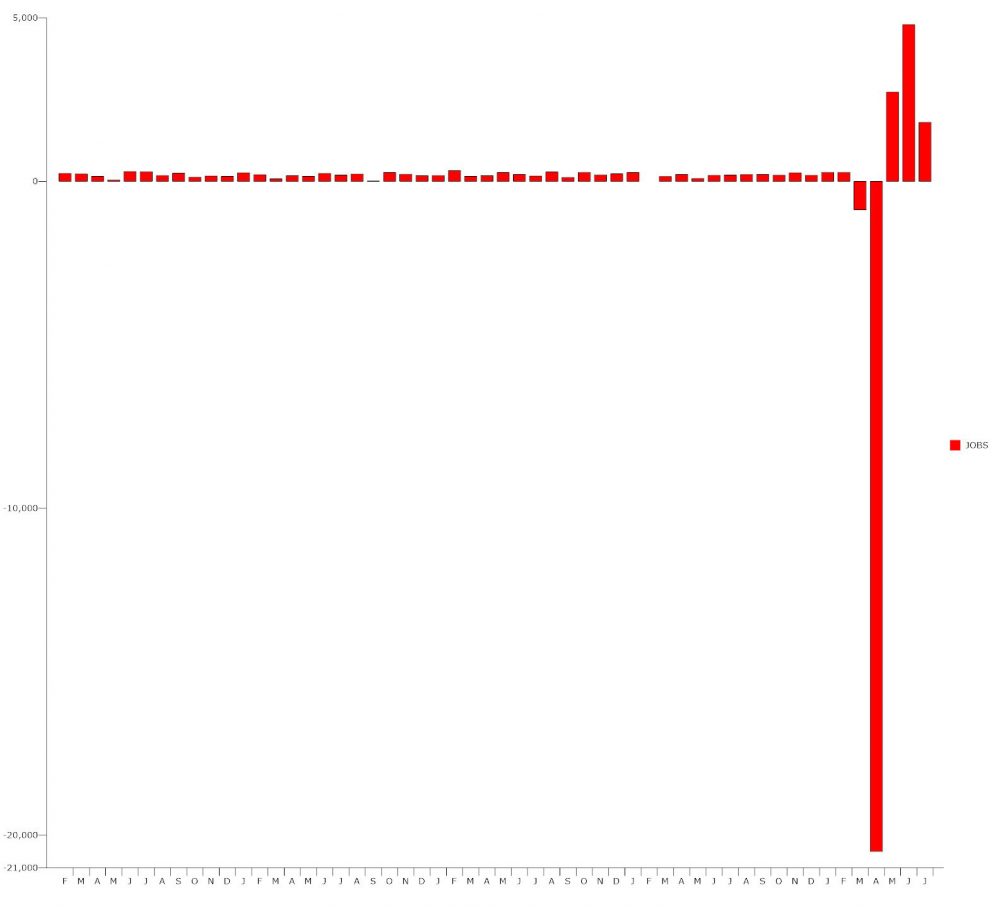
The national economy returned 1.8 million people to work in July and the unemployment rate decreased by just under 1 percent, to 10.2 percent–a few decimal points below the 1982-83 recession, when unemployment peaked at 10.8 percent. The April lockdown due to the coronavirus pandemic had sent the unemployment rate to 14.t percent that month.
But July’s improvement was slower than in May and June, reflecting the resurgence of covid-19 since Memorial Day across the nation and especially in large states such as Florida, Texas and California.
This week, Florida had an estimated 73,955 first-time unemployment claims last week, a drop of nearly 20 percent from the previous week as the state continues to try to recover economically from the coronavirus pandemic. Florida’s figure was down from 91,462 claims during the week that ended July 25 and was well below claims from April, when much of the state was shut down to try to control the spread of COVID-19, the respiratory disease caused by the coronavirus. DeSantis began efforts May 4 to reopen businesses.
While Florida showed improvement last week, only California had more first-time claims, with an estimated 228,530. New York, with 73,740 new claims, and Georgia, with 72,695 claims, were just behind Florida for the week.
Leisure and hospitality gained more than half a million jobs, totaling a gain of 2 million in the last three months. Despite the gains, however, employment in restaurants and bars remains 2.6 million below February’s level. In Florida, bars are still under orders to remain closed because of the covid resurgence.
Government added 300,000 jobs but is still 1.1 million lower than in February. Retail trade, professional and business services and health care all made gains in July, but the rate of job growth was half that of June, while the number of people holding jobs remains 12.9 million (or 8.4 percent) below February’s level. The current unemployment rate is 6.7 percentage points above that of February. Put another way, 42 percent of jobs lost to the pandemic have so far been regained, suggesting that gains ahead, while almost certain, will be a slow slog.
As has been true even before the pandemic–though the pandemic has exacerbated the trend–Blacks are sustaining the highest rate of unemployment, 14.6 percent in July, little changed from the month before, followed by Hispanics (12.9 percent), Asians (12 percent) and whites (9.2 percent). Asians before the pandemic had for at least 10 years had a lower unemployment rate than whites, sometimes by significant margins (Asians’ unemployment rate was 2.5 percent in February, the last month before the pandemic struck, compared to 3.1 percent for whites). Asians’ higher unemployment numbers may reflect increased prejudice against Asians, which has been rampant, because the coronavirus’ origins in China.
Last week federal unemployment supplements of $600 a week ran out. The supplements helped many families weather the downturn, especially in Florida, which–at a maximum of $275 a week for just 12 weeks–has the stingiest unemployment benefit in the nation, with some of the strictest rules to qualify. Senate Republicans have so far blocked an extension or renewal of supplemental unemployment benefits.
The Florida Department of Economic Opportunity has distributed $13 billion in state and federal assistance to 1.8 million unemployment claimants. The bulk of the money came from a $600-a-week federal unemployment benefit, which expired at the end of July. Florida Senate Democrats, who have repeatedly pushed for a special session to address the economy and the unemployment system, noted Wednesday that about 1.45 million Floridians continued to wait for payments.
Nationally, average weekly hours for all private-sector workers fell by 0.1 hour in July, while average hourly earnings rose 7 cents, to $29.39, though the Bureau of Labor Statistics notes that changes in average hourly earnings in recent months must be interpreted with caution. The number of people who usually work part time increased by 803,000 in July, to 24 million. Those who worked part-time for economic reasons–meaning that their hours had been cut back or they could not find full-time employment–decreased by 619,000, to 8.4 million, reflecting a decline in the number of people whose hours were cut due to slack work or business conditions. But that total remains 4.1 million higher than in February.
–FlaglerLive and the News Service of Florida




























Leave a Reply